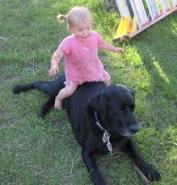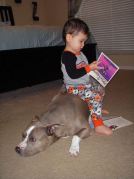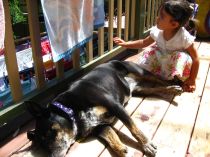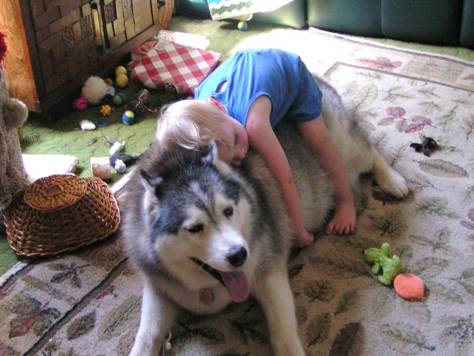A SAMPLE OF “KIDS WITH DOGS” PHOTOS TAKEN FROM A 30-SECOND GOOGLE SEARCH
Disclaimer: If you are not horrified by these photographs (even worse….if you think they are cute), you are probably not going to like what follows.
A few statistics: According to the CDC, approximately 4.5 million people are bitten by dogs each year. Of these reported bites, a large victim demographic is children under the age of 10. Children are most likely to be bitten severely enough to require medical care or hospitalization. They are also most frequently bitten by their own dog or by a dog who they know, such as the dog belonging to a neighbor or relative. Bites to the face and neck are common in children, most likely because of their size and the types of behavior that they engage in with dogs.
Why is this surprising? Really now. If I can find the preceding photographs with a seconds-long Google search, then my guess is that there are a lot more of these photos out there and many more interactions of this type taking place between children and dogs each day. Indeed, such evidence suggests that our dogs are, in general, much more tolerant and accepting of abuse than we ever give them credit for. Unsafe (and potentially unkind) behavior of children towards dogs appears to be epidemic in our society.
Bite Prevention Programs for Kids: The good news is that these alarming dog bite statistics have led to the development of bite prevention programs. Though not many have been thoroughly studied or validated, there is some evidence showing that these programs can influence the beliefs and behavior of children:
- Prevent-A-Bite: Grade school children (7 to 8 years of age) completed a 30-minute lesson that provided instruction for behaving appropriately and safely around dogs (1). Following the lesson, the children had the opportunity to interact with a friendly dog. Of the children who completed the program, only 9 percent behaved inappropriately with the dog. By comparison, 79 percent of children of the same age who had not completed the Prevent-A-Bite lesson (the control group) showed inappropriate behavior upon meeting the dog.
-
BARK Program (Be Aware, Responsible and Kind): This study was a pre-test/post-test evaluation with 500 children, aged 6 to 9 years (2). After reading and completing activity workbooks and watching a video, children showed improved knowledge about how to behave with dogs. (Note: This study did not include a test with a live dog).
- Delta DogSafe Program: A group of young children, 3 to 5 years of age, completed a program that used photographs and a puppet show to model safe behavior with dogs (3). Children who completed the training were more likely to recognize potentially dangerous behaviors depicted in dogs in photographs than children who had not completed the training. (Note: This study did not include a test with a live dog).
- The Blue Dog Program: The Blue Dog is an interactive computer program designed for children between 3 and 6 years of age and their parents. It includes a series of animated scenarios of a dog and a child and the user must make decisions about how (or if) the child character interacts with the dog in each scene. The program provides instant feedback regarding appropriate behavior with dogs. A recent study examined the learning outcomes of using Blue Dog in 76 children (4). After a week of using the program with their parents, children were better able to recognize risky situations when shown photographs of dogs. However, the children who had used the program did not change their actual behavior when presented with an unfamiliar live dog or when tested using scenarios with dolls.
The kids are alright: The results of these studies suggest that children can benefit from dog bite prevention programs in terms of their reported knowledge, and that older children can transfer these lessons to live interactions with unfamiliar dogs. It appears that the transfer of understanding into behavior may be less effective in younger children, however. (Note: No studies to date have evaluated post-test behaviors with familiar dogs, an important issue seeing that the majority of bites come from known dogs).
WHAT ABOUT THE PERSON ON THE OTHER SIDE OF THE CAMERA?
The parents, on the other hand…… In their 2011 study of Blue Dog, David Schwebel, Barbara Morrongiello and their colleagues also collected data from the parents of the 3- to 6-year-olds. They reported some rather disturbing findings:
-
76 % of the parents believed that their child already knew most or all of the information that Blue Dog provided (remember, these kids were just 3 to 6 years of age).
- A majority of parents (65 %) also believed that their child would apply most or all of what they learned from the program to interactions with their own dog. (Seems to be rather contradictory, seeing that they believed their kid already knew everything…….I was confused).
- And, most parents admitted that they did not read the Parent Guide completely (93 percent actually), which included information about safe behavior between children and dogs. (It appears that the parents were certain that they too already knew everything there was to know about proper dog interactions).
Given that parental supervision and good judgment are key components to safe interactions between small children and dogs, the same group of researchers decided to test the effectiveness of Blue Dog training on the behavior of parents – specifically how parental supervision during interactions between children and dogs was influenced by completion of Blue Dog training (5).
The Study: The researchers had two objectives. First, they examined the typical supervisory practices of parents of preschool children when their child was in the presence of an unfamiliar dog. They then assessed changes in parental supervision several weeks after the parents had completed the Blue Dog program with their child. The study groups included 55 child/parent pairs, each of which lived with at least one adult dog. Half of the families completed Blue Dog training and half (the control group) completed a similar type of computer program that provided fire safety education. A pre/post test method was used in which the parent and the child were brought into a room in which a gentle and friendly dog was present with his/her trainer. The parents were given no information about the dog’s temperament and were told that there would be a dog in the room immediately prior to entering the room. Measured parent outcomes included reactions to seeing their child in the vicinity of an unfamiliar dog and to interacting with the dog and the presence/absence/intensity of supervisory behaviors.
The Results: Results were reported for the pre-test (before Blue Dog training) and post-test (after Blue Dog Training) sessions.
- Pre-test session: Children in both the test group and the control group showed cautious behaviors upon seeing the unfamiliar dog. In contrast, the majority of the parents demonstrated risky behaviors that included encouraging their child to immediately approach the dog or immediately approaching the dog themselves. Most of the children did eventually interact with the dog, either on their own or as a result of encouragement from the parent. There were no differences between the test group and the control group, but…..here’s the kicker……the collective behaviors of the parents were scored as being significantly more risky than those of their children.
- Post-test session: Following Blue Dog training, once again, the children were appropriately cautious when confronted with an unfamiliar dog (a different dog from session 1). Their parents, on the other hand, continued to demonstrate risky behaviors. (Parental behavior trended toward less risky behaviors after the training, but the difference was not statistically significant; P = 0.07). Following training, there were no significant differences between the test group that had completed Blue Dog and the control group – in other words, the training had no statistically significant effect on the behavior of either the children or their parents. (The children continued to behave cautiously; the parents, well, they continued to behave badly).
- Both Sessions: In both sessions, parents stayed in proximity of their children and demonstrated high degrees of attentiveness. This result is an important one because it showed that while the parents’ behaviors with the dog and with the child-dog interactions were unsafe, they consistently demonstrated overall good general parenting supervision.
The results of this study suggest that a large proportion of the problem, at least for young children, lies not with the kids, but with the parents. And, the problem appears to NOT be one of inattention or poor supervision, as the parents in this study did stay in proximity of their children and did pay attention to them. Rather, at issue is parents’ beliefs about appropriate behaviors when interacting (and encouraging their child to interact) with dogs.
DRAGGIN’ OUT THE OL’ SOAP BOX AGAIN
Like many trainers, I cringe when new clients say to me “Oh, our Rover is such a great dog! My kids and their friends can do anything to him – sit on him, grab his skin, pull his tail, and he just takes it! Isn’t he a wonderful family dog?”. Similarly, my teeth clench when I open emails from well-meaning (though misguided) people who send me photos such as those posted above because “You like dogs, so you will love this photo of little Johnny crawling on top of our dog“. Yeah…..well, no.
To all parents: Your child should not sit on your dog while reading a book. Nor should he ride your dog like a pony, sprawl across her whilst she is napping, grab your dog’s face in his fist, pull on her skin or tail, or stick a hand into her food bowl. Not only are these behaviors disrespectful and borderline (sometimes not even borderline) abusive, but they are dangerous. Your loving, sweet family dog who has finally had enough abuse and air snaps at your child in response to these unsafe behaviors will pay dearly for that snap if she makes contact. Both your child and your dog pay (with the dog possibly paying the ultimate price – her life).
Not only should you prevent your child from doing these things (even if you live with that wonderful dog who allows it), you should model kindness and respect and proper interactions with dogs – all dogs – starting with your own.
References:
- Chapman S, Cornwall J, Righetti, Sung J. Preventing dog bites in children: randomized controlled trial of an educational intervention. British Medical Journal 2000; 320:1512-1513.
- Spiegel IB. A pilot study to evaluate an elementary school-based dog bite prevention program. Anthrozoos 2000; 13:164-173.
- Wilson F, Dwyer F, Bennett PC. Prevention of dog bites: Evaluation of a brief educational intervention program for children. Journal of Community Psychology 2003; 31:75-86.
- Schwebel DC, Morrongiello BA, Davis AL, et al. The Blue Dog: Evaluation of an interactive software program to teach young children how to interact safely with dogs. Journal of Pediatric Psychology 2012; 37:272-281.
- Morrongiello BA, Schwebel DC, Stewart J, et al. Examining parents’ behaviors and supervision of their children in the presence of an unfamiliar dog: Does The Blue Dog intervention improve parent practices? Accident Analysis and Prevention 2013; 54:108-113.









Pingback: 10 Years of Dog Science | The Science Dog